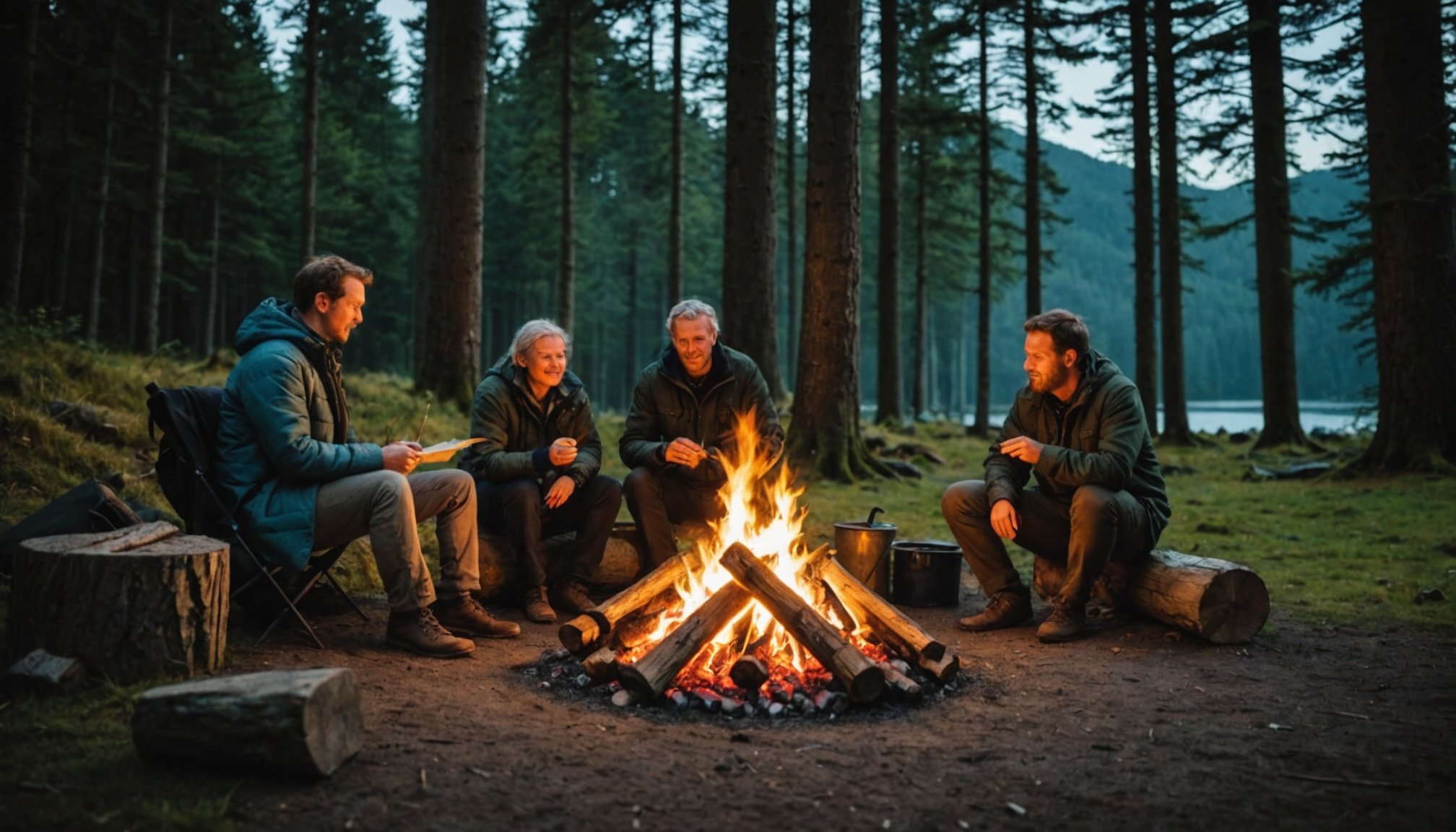The Complete Handbook for Enjoying a Safe and Eco-Friendly Campfire Adventure in the UK
Planning Ahead and Preparing for Your Camping Trip
Before you embark on your camping adventure, it’s crucial to plan ahead and prepare thoroughly. This not only ensures a safe and enjoyable experience but also helps in minimizing your impact on the environment.
Know the Regulations and Special Concerns
Understand the regulations and special concerns of the area you will be visiting. For instance, some campsites may have specific rules about campfires, waste disposal, and group sizes. Knowing these regulations in advance can help you avoid any unintended harm to the environment and ensure you have a smooth trip[1].
Have you seen this : The complete blueprint for designing an epic week-long camping meal plan for your uk getaway
Prepare for Extreme Weather and Emergencies
Weather conditions in the UK can be unpredictable, so it’s essential to prepare for extreme weather, hazards, and emergencies. Pack appropriate gear such as waterproof clothing, a first aid kit, and a map and compass. This preparation will help you navigate safely and respond to any unexpected situations that may arise[1].
Schedule Your Trip and Visit in Small Groups
Schedule your trip to avoid times of high use, and consider visiting in small groups. This helps in reducing the overall impact on the environment and preserves the natural beauty of the area. Split larger parties into smaller groups to minimize soil erosion and protect delicate vegetation[1].
Also to read : Uncover the top uk campsites for unforgettable equestrian escapades: the definitive guide to booking horse riding adventures!
Repackage Food and Minimize Waste
Repackage your food to minimize waste and use reusable containers. This simple step can significantly reduce the amount of trash you generate during your trip. Remember to pack out all rubbish, leftover food, and litter, and avoid burning rubbish as it is never recommended[1].
Choosing the Right Eco-Friendly Camping Gear
The gear you choose can make a significant difference in your environmental impact. Here are some tips for selecting eco-friendly camping gear:
Eco-Conscious Tents and Sleeping Bags
Opt for tents made from recycled or sustainable materials such as recycled polyester or organic cotton. These tents are durable, water-resistant, and reduce your carbon footprint. Similarly, choose sleeping bags filled with recycled materials or responsibly sourced down. These options are not only eco-friendly but also provide the same level of comfort and warmth as traditional sleeping bags[2].
Sustainable Cookware and Utensils
When it comes to cooking, opt for reusable stainless steel or titanium cookware. These materials are durable, lightweight, and easy to clean. Avoid single-use items and invest in reusable cutlery and dishware. Bamboo utensils and plates are great alternatives as they are lightweight and biodegradable[2].
Backpacks Made from Sustainable Materials
Choose backpacks made from recycled materials or sustainable fibers. Brands are now offering backpacks produced from recycled ocean plastics, which help reduce waste in our seas. These backpacks are durable, water-resistant, and come with features like solar charging ports[2].
Setting Up Your Campsite with Minimal Impact
Setting up your campsite in a way that minimizes your impact on the environment is crucial for sustainable camping.
Travel and Camp on Durable Surfaces
Use durable surfaces like established trails, campsites, rock, gravel, and dry grass to minimize soil erosion and protect delicate vegetation. When camping, choose sites that are at least 200 feet from lakes and streams to preserve water sources and wildlife habitats. Good campsites are found, not made, so avoid altering the site unnecessarily[1].
Dispose of Waste Properly
Proper waste disposal is essential to protect the environment. Deposit solid human waste in catholes dug 6-8 inches deep and at least 200 feet from water, camp, and trails. Cover and disguise the cathole when finished. Pack out all rubbish, leftover food, and litter. For washing, carry water 200 feet away from streams or lakes and use small amounts of biodegradable soap[1].
Building and Managing Your Campfire Responsibly
Campfires are a traditional part of the camping experience, but they can have significant environmental impacts if not managed properly.
Minimize Campfire Impact
Campfires can cause lasting impacts on the environment, so it’s important to use them responsibly. Use established fire pits where fires are permitted, and keep fires small by using only sticks from the ground that can be broken by hand. Burn all wood and coals to ash, put out campfires completely, and scatter cool ashes. Consider using a lightweight stove for cooking instead of building a campfire[1].
Tips for Safe and Eco-Friendly Campfires
- Use Firewood Wisely: If you must have a campfire, use firewood that is locally sourced and sustainable. Avoid cutting down trees or damaging vegetation.
- Keep Fires Small: Small fires are easier to manage and produce less smoke and ash.
- Use Biodegradable Soap: When washing dishes or yourself near a campfire, use biodegradable soap to avoid harming local water sources.
- Pack It In, Pack It Out: Ensure that all waste, including food scraps and packaging, is packed out and not left at the campsite.
Leave What You Find: Respecting Nature
Leaving what you find is a core principle of sustainable camping. Here’s how you can respect nature during your trip:
Avoid Introducing Non-Native Species
Avoid introducing or transporting non-native species, as they can disrupt the local ecosystem. This includes plants, animals, and even microorganisms that could harm the environment[1].
Leave Rocks, Plants, and Other Natural Objects
Leave rocks, plants, and other natural objects as you find them. These items play important roles in their ecosystems and contribute to the story of the landscape. By leaving them in place, you help preserve their significance and allow others to experience the same sense of discovery[1].
Preserve Cultural and Historic Structures
Observe cultural or historic structures and artifacts, but do not touch them. These sites are part of our collective heritage and should be treated with respect and care[1].
Essential Gear for Eco-Friendly Camping
Here are some essential gear items that can help you enjoy a sustainable and eco-friendly camping experience:
Reusable Stainless Steel Cookware
Opt for reusable stainless steel cookware, which is durable, lightweight, and easy to clean. This cookware is ideal for cooking over campfires or portable stoves and is resistant to rust[4].
Refillable Gas Canisters
Choose refillable gas canisters instead of disposable ones. These can be used multiple times with the right adapters, saving money and reducing landfill waste[4].
Compostable Tableware
Use biodegradable plates, bowls, and cutlery made from materials like bamboo. These products decompose naturally and leave no harmful waste behind[4].
Reusable Water Bottles and Filters
Use reusable water bottles paired with filtration systems or purification tablets. This reduces plastic waste and makes clean drinking water accessible anywhere[4].
Tips for Sustainable Camping
Here are some additional tips to help you make your camping trip more sustainable:
Pack It In, Pack It Out
Leave no trash behind—carry all waste back with you. This includes food scraps, packaging, and any other items you brought with you[4].
Use Multi-Purpose Gear
Reduce your load by choosing gear that serves multiple purposes. For example, a multi-tool can replace several single-use items[4].
Leave No Trace
Minimize your environmental impact by sticking to marked trails and campsites. Avoid altering the natural environment in any way that could cause lasting damage[4].
Best UK Campsites for Eco-Friendly Camping
If you’re looking for campsites that support eco-friendly camping practices, here are some of the best options in the UK:
Eweleaze Farm, Weymouth
Eweleaze Farm is located in an area of outstanding natural beauty and offers extensive sea views. The campsite has recycling facilities, solar showers, and allows campfires, making it a great option for those who want to enjoy the outdoors while being mindful of their environmental impact[3].
Cloud Farm, Devon
Cloud Farm is perfect for nature lovers, with a shallow river running through the campsite and plenty of space for kids to play. The site has clean and well-presented toilets and showers, and it’s a great base for days spent rambling on Exmoor[5].
Great Langdale Campsite, Lake District
Great Langdale Campsite is ideal for outdoor adventures, offering stunning views and access to various hiking trails. The site encourages sustainable camping practices and provides facilities that make it easy to minimize your environmental impact[5].
Practical Insights and Actionable Advice
Here are some practical insights and actionable advice to make your camping trip both safe and eco-friendly:
Be Mindful of Water Sources
When washing dishes or yourself, carry water 200 feet away from streams or lakes to avoid contaminating water sources. Use small amounts of biodegradable soap to minimize the impact on local wildlife[1].
Use Eco-Friendly Toiletries
Use biodegradable soap, toothpaste, and wipes to keep your campsite clean without damaging the environment. These products are gentle on skin and the planet[4].
Respect Wildlife Habitats
Avoid camping near wildlife habitats and keep your campsite small to minimize the disturbance to local ecosystems. Focus your activity in areas where vegetation is absent to reduce your impact[1].: Camp Green, Camp Smart
Camping is a wonderful way to connect with nature, but it’s our responsibility to ensure that we do so in a way that protects the environment for future generations. By choosing eco-friendly gear, following the Leave No Trace principles, and being mindful of our actions, we can enjoy the great outdoors while minimizing our environmental impact.
As outdoor enthusiast and Leave No Trace advocate, Rachel Stevens, puts it: “The beauty of nature is a gift to us all. By taking small steps to reduce our impact, we can ensure that this beauty remains for generations to come.”
So, the next time you plan a camping trip, make sure to pack your eco-friendly gear, follow sustainable camping tips, and leave no trace behind. Together, we can preserve the beauty and health of our natural spaces.
Table: Comparing Eco-Friendly Camping Gear
| Gear Item | Eco-Friendly Option | Benefits | Alternatives |
|---|---|---|---|
| Tents | Recycled Polyester or Organic Cotton | Durable, water-resistant, reduces carbon footprint | Traditional polyester tents |
| Cookware | Reusable Stainless Steel or Titanium | Durable, lightweight, easy to clean | Disposable plastic cookware |
| Utensils | Bamboo or Biodegradable | Lightweight, biodegradable | Single-use plastic utensils |
| Backpacks | Recycled Materials or Sustainable Fibers | Durable, water-resistant, reduces waste | Traditional backpacks made from non-recycled materials |
| Water Bottles | Reusable with Filtration Systems | Reduces plastic waste, provides clean drinking water | Single-use plastic water bottles |
| Sleeping Bags | Recycled Materials or Responsibly Sourced Down | Comfortable, warm, eco-friendly | Traditional sleeping bags made from non-recycled materials |
Detailed Bullet Point List: Tips for a Safe and Eco-Friendly Campfire
- Plan Ahead: Know the regulations and special concerns for the area you’ll visit.
- Prepare for Weather: Pack appropriate gear for extreme weather conditions.
- Use Durable Surfaces: Camp on established trails, campsites, rock, gravel, and dry grass.
- Dispose of Waste Properly: Pack out all rubbish, leftover food, and litter.
- Minimize Campfire Impact: Use established fire pits, keep fires small, and burn all wood and coals to ash.
- Leave What You Find: Avoid introducing non-native species and leave rocks, plants, and other natural objects as you find them.
- Use Eco-Friendly Gear: Opt for reusable stainless steel cookware, refillable gas canisters, and biodegradable tableware.
- Respect Wildlife Habitats: Avoid camping near wildlife habitats and keep your campsite small.
- Be Mindful of Water Sources: Carry water 200 feet away from streams or lakes and use biodegradable soap.
- Use Multi-Purpose Gear: Reduce your load by choosing gear that serves multiple purposes.
- Pack It In, Pack It Out: Leave no trash behind—carry all waste back with you.








